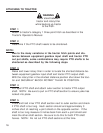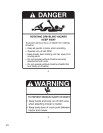
NOTE: Do not allow the tractor engine or rotary tiller to bog down or stall. This
causes undue wear and tear on the tiller and tractor. If this continues to happen
reduce ground speed and raise tilling depth of rotary tiller. Never attempt to re-
move objects from the rotor bar until the tractor has been shut down and the tiller
tines have completely stopped.
WARNING
Never travel at a fast ground speed while using the tiller, this could damage it.
Never attempt to turn the tractor or travel in reverse with the PTO engaged and
the tiller in the ground. Always raise the tiller out of the ground when backinig up
or attempting to turn. Failure to due so may cause damage to the tiller.
STEP 8
After each use clean all debris from the tiller tines. Replace any missing or illegible safety
decals. Inspect for any damaged or worn parts and replace before next use. Store rotary
tiller in a dry environment.
MAINTENANCE
1). Periodically check and maintain proper gear oil level.
2). Every 8 hours, (1) grease "out-board hub", (2) PTO shaft universal joints, (3) PTO
shaft safety shield and (4) PTO telescoping surface.
NOTE: Use only a grade Type II tube grease.
NOTE: Do not grease the slip clutch assembly.
3). Before each use check to make sure all safety shields are installed and working
properly.
4). Check tiller tines for cracks and breaks before every use.
5). Periodically check all nuts and bolts to insure they are tight and secure.
6). Periodically loosen torque spring bolts and allow slip clutch to slip for approximately
two (2) revolutions. Loosen the bolts until the springs lose contact with the flange
yoke. This ensures that the slip clutch is not in a "locked" position.
7). Make sure that the clutch slips.
8). To retighten the slip clutch, tighten the torque spring bolts until the nut makes contact
with the flange yoke and further tighten one and a half turns (1-1/2). This is a good
starting point , further adjustments may need to be made based on soil conditions.
NOTE: Do not over or under tighten slip clutch assembly or damage may occur.
MAINTENANCE SAFETY
z Good maintenance is your responsibility. Poor maintenance is an invitation to trouble.
z Follow good shop practices.
z Keep service area clean and dry
20


















